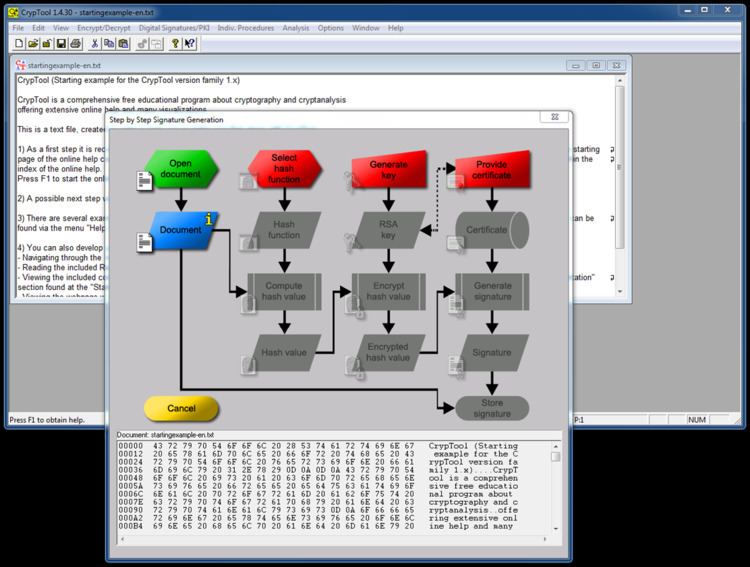 | ||
Developer(s) Bernhard Esslinger,– University of Darmstadt– University of Duisburg-Essen– University of Kassel / Applied Information Security– University of Siegen Initial release 1998; 19 years ago (1998) Stable release CT 1.4.30 (August 4, 2010)CT 2.0 (August 20, 2014) Preview release CT 1.4.31 Beta 6b (October 2013)JCT 1.0 RC8 (October 2016) Repository github.com/jcryptool/core Operating system | ||
CrypTool is an open source project. Main result is the free e-learning software CrypTool illustrating cryptographic and cryptanalytic concepts. According to "Hakin9" CrypTool is worldwide the most widespread e-learning software in the field of cryptology.
Contents
CrypTool implements more than 300 algorithms. Users can adjust these with own parameters. The graphical interface, online documentation, analytic tools and algorithms of CrypTool introduce users to the field of cryptography. CrypTool contains the most classical ciphers as well as modern symmetric and asymmetric cryptography including RSA, ECC, digital signatures, hybrid encryption, homomorphic encryption, and Diffie–Hellman key exchange. Also methods from the area of quantum cryptography (like BB84 key exchange protocol) and the area of post-quantum cryptography (like McEliece, WOTS, Merkle-Signature-Scheme, XMSS) are implemented. Many methods (for instance Huffman code, AES, Keccak, MSS) are visualized.
In addition it contains: didactical games (like Number Shark, Divider Game, or Zudo-Ku) and interactive tutorials about primes, elementary number theory, and lattice-based cryptography.
Development, history and roadmap
The development of CrypTool started in 1998. Originally developed by German companies and universities, it is an open source project since 2001. More than sixty people worldwide contribute regularly to the project. Contributions as software plugins came e.g. from universities or schools in the following towns: Belgrad, Berlin, Bochum, Brisbane, Darmstadt, Dubai, Duisburg-Essen, Eindhoven, Hagenberg, Jena, Kassel, Klagenfurth, Koblenz, London, Madrid, Mannheim, San Jose, Siegen, Utrecht, Warsaw.
Currently 4 versions of CrypTool are maintained and developed. The CrypTool 1 (CT1) software is available in 6 languages (English, German, Polish, Spanish, Serbian, and Greek). A project for a French version was begun end of 2013. CrypTool 2 (CT2), JCrypTool (JCT) and CrypTool-Online (CTO) are available in English and German.
The goal of the CrypTool project is to make users aware of how cryptography can help against network security threats and to explain the underlying concepts of cryptology.
The current release version of CT1, CrypTool 1.4.30, was published in August 2010. It is written in C++ and designed for the Microsoft Windows operating system. A port of CrypTool 1 to Linux with Qt4 was started, but currently there is no progress.
In 2007, development began on two additional projects, both based on a pure-plugin architecture, to serve as successors to the original CrypTool program. Both successors regularly publish new stable betas:
Awards
CrypTool has received several international awards as an educational program, such as the TeleTrusT Special Award 2004, EISA 2004, IT Security Award NRW 2004, and Selected Landmark in the Land of Ideas 2008 award.
Use
CrypTool is used in schools, universities, companies and agencies for education and awareness training.
Worldwide, the CrypTool packages are downloaded more than 10,000 times per month from the CrypTool website. Just over 50% of the downloads are for the English version.
CrypTool-Online
The CrypTool project also includes the websites CrypTool-Online and CrypTool Mobile. These websites allow users to try cryptographic methods directly within a browser on a PC or a smartphone (using JavaScript), without the need to download and install software. These two sites aim to present the topic in an easy and attractive way for new users and young people. Advanced tasks still require the offline versions of CrypTool.
MysteryTwister C3 (MTC3)
In 2010, the international cipher contest MTC3 started as part of the CrypTool project. The contest currently offers more than 200 challenges derived from old and modern ciphers and designed by more than 30 different authors from different countries. All challenges are presented in PDF templates in English and German. The challenges are clustered in four levels of difficulty, which range from simple riddles solvable with paper-and-pencil to mathematical challenges from modern cryptanalysis for researchers and experts. Additionally, a moderated forum, user statistics, and a hall-of-fame are available. Currently, more than 7000 registered users are engaged in solving these challenges.
